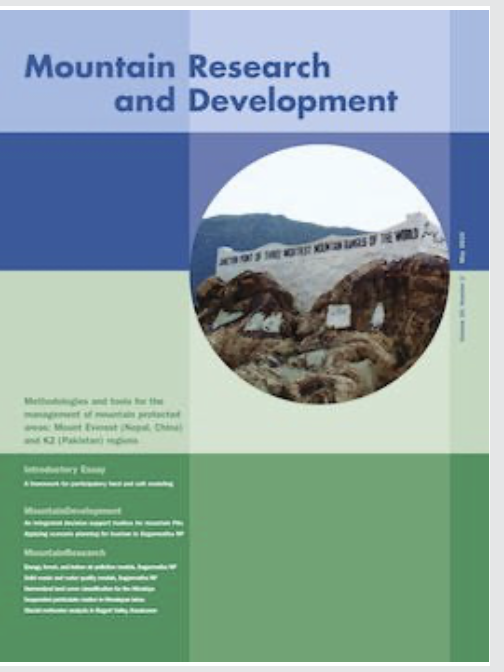Keyword
system dynamics
3 record(s)
Type of resources
Topics
Keywords
Contact for the resource
Provided by
Update frequencies
Status
-

This paper presents the results of management-oriented research on energy, forest, and human health issues in a remote mountain area, the Sagarmatha National Park and Buffer Zone (SNPBZ), Nepal. The research was based on a broader, integrated participatory framework ultimately intended for use in adaptive management. The present study focused on the application of a participatory modeling framework to address problems related to energy demand and consumption, forest condition, and indoor air pollution, which were defined by the stakeholders as important issues to be addressed. The models were developed using a generalizing design that allows for user-friendly adaptation to other contexts (free download at http://hkkhpartnership.org). Moreover, we simulated management scenarios in collaboration with all modeling actors with the aim of building consensus on the understanding of the system as well as supporting decision-makers' capacity not only to respond to changes, but also to anticipate them. Importantly, the system dynamics assessment found that the SNPBZ forests are affected by an increasing demand for fuelwood (occurring due to tourism growth), as one of the main sources of energy. Selected forests show an average reduction of 38% in forest biomass from 1992 to 2008. This shows that the business-as-usual scenario is unlikely to result in the preservation of the current forest status; in fact, such preservation would require 75% of fuelwood to be replaced with alternative energy sources. At the same time, a 75% reduction of fuelwood use (and an 80% reduction of dung use) would reduce indoor carbon monoxide (CO) concentrations to the standard limits for CO exposure set by the World Health Organization.
-

The problem of supporting decision- and policy-makers in managing issues related to solid waste and water quality was addressed within the context of a participatory modeling framework in the Sagarmatha National Park and Buffer Zone in Nepal. We present the main findings of management-oriented research projects conducted within this framework, thus providing an overview of the current situation in the park regarding solid waste and water quality issues. We found that most of the solid waste generated in the park is composed of organic matter, paper, and minor reused waste that is mainly reused for cattle feeding and manure, while disposal of other nondegradable categories of collected waste (glass, metal, and plastic) is not properly managed. Particularly, burning or disposal in open dumps poses a great hazard to environmental, human, and animal health, as most dump sites situated close to water courses are prone to regular flooding during the rainy season, thereby directly contaminating river water. Pollutants and microbiological contamination in water bodies were found and anthropogenic activities and hazardous practices such as solid waste dump sites, open defecation, and poor conditions of existing septic tanks are suggested as possibly affecting water quality. Collection of these data on solid waste and water quality and compilation of management information on the targeted social-ecological system allowed us to develop consensus-building models to be used as management supporting tools. By implementing such models, we were able to simulate scenarios identifying and evaluating possible management solutions and interventions in the park. This work reveals insights into general dynamics that can support the quest for solutions to waste and water quality management problems in other protected areas and mountain landscapes where traditional livelihood and land use patterns are changing under the influence of a growing population, changing consumption patterns, and international tourism.
-

New tools and methodologies are required in systemic planning and management of mountain protected areas. Among others we propose here a decision support toolbox (DST) conceived as an integrated collection of both soft and hard system methodologies, consisting of participatory and computer-based modules to provide a set of integrated, self-contained tools and approaches to support decision-making processes in the management of mountain protected areas. The Sagarmatha National Park and Buffer Zone (SNPBZ) in Nepal was taken as a pilot case. A number of participatory exercises such as participatory 3-dimensional modeling, scenario planning, and qualitative modeling were carried out to understand social-ecological processes and generate a systemic view over space and time. The qualitative models were then converted into computer-based system dynamics models. The design and development of DST software were carried out with an incremental and modular approach. This process involved stakeholder analysis and decision-making processes through a series of consultations. The software was developed with the main modules including scenario analysis, spatial analysis, and knowledge base. The scenario analysis module runs system dynamics models built in Simile software and provides functions to link them with spatial data for model inputs and outputs. The spatial analysis module provides the basic geographic information system functions to explore, edit, analyze, and visualize spatial information. The knowledge base module was developed as a metadata management system for different categories of information such as spatial data, bibliography, research data, and models. The development of DST software, especially system dynamics modeling and its linkage with spatial components, provided an important methodological approach for spatial and temporal integration. Furthermore, training and interactions with park managers and concerned stakeholders showed that DST is a useful platform for integrating data and information and better understanding ecosystem behavior as a basis for management decisions.
